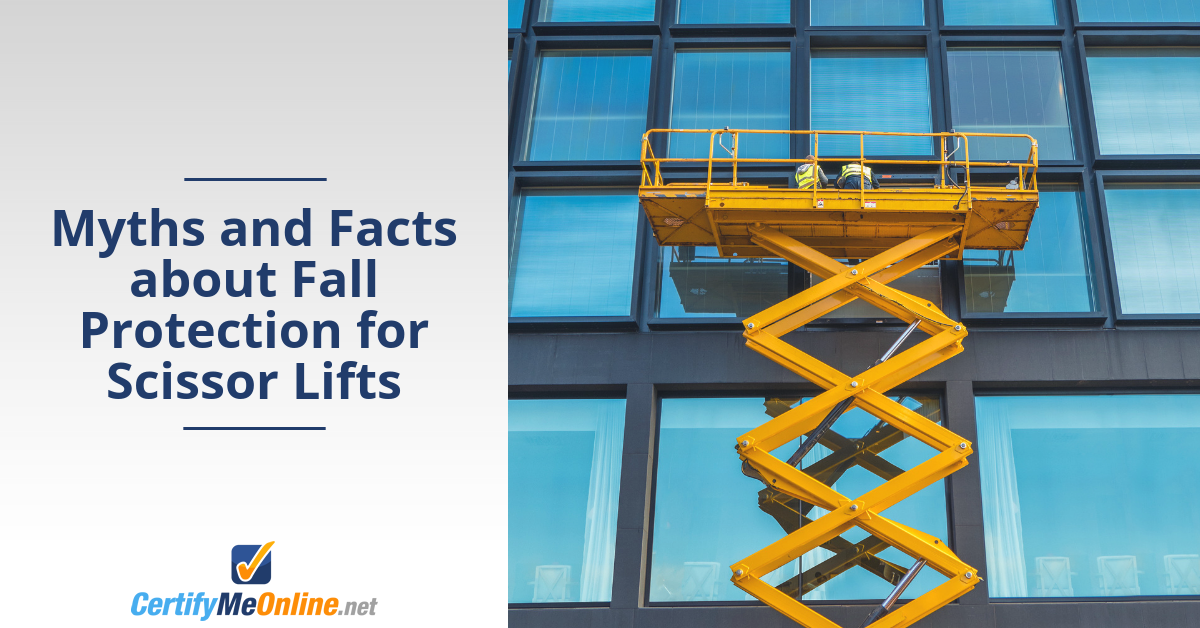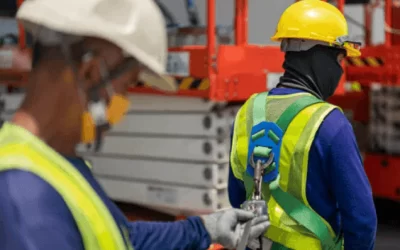Fall Protection Equipment and Scissor Lifts – Separating Myths from Facts
Aerial lifts differ from scissor lifts when it comes to fall protection equipment. Since aerial lifts and other aerial work platforms (AWPs) extend to huge heights – some reach well over 100 ft. into the sky – they’re subject to certain fall protection requirements from OSHA.



Scissor lifts, however, are much closer to the ground. Most scissor lifts have a maximum extension of 30-40 ft. That’s high enough to cause accidents and injuries from falls, but not quite as dangerous as aerial lifts.
Given the confusion surrounding fall protection equipment with scissor lifts, many myths exist about scissor lift fall protection. We can help you with all aspects related to fall protection training – it’s just one of the many subjects you’ll learn about with our OSHA compliant courses.
With OSHA audits and inspections, you and your company could be fined thousands of dollars for failure to comply with safety rules and regulations. What’s more, it’s against the law to operate an aerial lift or scissor lift without training.
For scissor lift fall protection, our training courses definitely separate myths from facts. Let’s look at some of the most common ones now!
Scissor Lift Fall Protection and Fall Protection Lifts: What You Need to Know
Here are some myths and facts related to scissor lift fall protection.
Myth
A guardrail system is just as effective as fall protection equipment.
Fact
Guardrails offer protection against falls, but they are not foolproof. With guardrails, they provide a protective barrier against falls. But, if guardrails are damaged or deteriorating, they won’t necessarily stop a scissor lift operator from falling.
When it comes to scissor lift safety, you need to look beyond guardrails. Ultimately, it’s always best to have scissor lift fall protection equipment while working. This equipment includes lanyards, anchor points, harnesses, and other safety equipment.
Myth
You need fall protection equipment on a scissor lift.
Fact
OSHA doesn’t require fall protection equipment for this type of equipment. While fall protection isn’t required, some type of fall restraint barrier or guardrail is mandatory. Most scissor lifts come with built-in guardrails to prevent falls. But the bottom line is this: harnesses, lanyards, and other fall protection accessories aren’t required on scissor lifts. The main reason is that OSHA has existing safety rules in place for scissor lift workers, including:
– Proper positioning of scissor lift to avoid overreaching
– Ensure guardrail system is in place
– Keep feet on the scissor lift work platform, and never climb onto the guardrail
Keep in mind this important point: while OSHA doesn’t require scissor lift fall protection equipment, your worksite or local laws may say otherwise. Always follow the safety guidelines in place at your jobsite, and use OSHA guidelines in addition to the regulations that apply directly to your job. CMO recommends fall protection equipment for scissor lift workers, even though it’s not required by law.
Myth
Scissor lift operators never need fall protection equipment.
Fact
There are two instances in which scissor lift fall protection accessories are required:
Whenever a guardrail system isn’t in place or working.
When a worker is required to leave the regular work platform.
Always check with your safety supervisor to identify when these two situations apply to you!
Additionally, it is crucial to remember that fall protection equipment may not be a requirement, but it can be the difference between life and death. If you believe fall protection equipment may be beneficial, you should provide it to your workers. That way, scissor lift operators can use this equipment to minimize the risk of falls.
Myth
Scissor lift fall protection is the employee’s responsibility.
Fact
All fall protection equipment and systems – including those for scissor lift work – are the responsibility of your employer. Everything from a clean workspace to training to scissor lift fall protection equipment should be provided by your employer.
Scissor lift operators are responsible for using fall protection equipment correctly, too. With the proper training, scissor lift operators will know exactly how to use this equipment. As a result, these operators can protect themselves against falls.
Do You Need Fall Protection on a Scissor Lift?
Fall protection is vital on a scissor lift. If scissor lift operators leverage fall protection equipment, they can guard against falls that can otherwise cause serious injuries or fatalities.
Does a Scissor Lift Operator Need to Be Tied-Off?
OSHA does not require workers to be tied-off when working from a scissor lift that has properly maintained guardrails. But, scissor lift operators must work cautiously any time they work at heights.
Fall protection equipment is simple to deploy and helps scissor lift operators guard against accidents, injuries, and fatalities at heights. If scissor lift operators learn how to properly use and maintain this equipment, they can safely complete tasks at heights.



Get Scissor Lift Fall Protection Training Today
CertifyMeOnline.net training courses do more than just show you how to safely operate aerial lifts and scissor lifts. They also put important safety concepts in focus, so you can avoid hazards and accidents. Our affordable courses include in-depth training content which allows you to pass your training test with flying colors. Plus, we also offer three-year renewal training and exceptional customer support. Whenever OSHA rules and regulations change, our courses update automatically with the relevant content.
Choose CertifyMeOnline.net for your aerial lift and scissor lift training needs. From fall protection to accident avoidance and more, we’re the best choice for OSHA compliant training at the right price! If you have any questions about our scissor lift or aerial lift fall protection training, give us a call at (602) 277-0615. Thanks for considering us for your scissor lift fall protection training.

